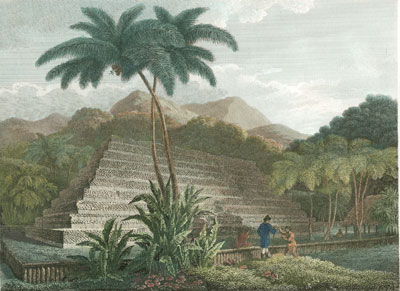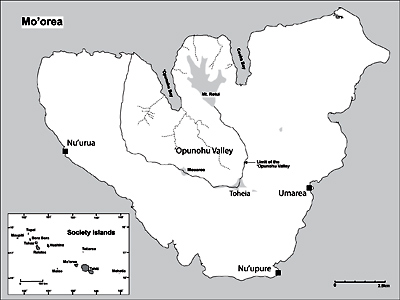Coral tests show fast construction pace for Polynesian temples
Ancient Polynesians went from building small-scale temples to constructing monumental, pyramid-shaped temples in just 140 years, not in four or five centuries as previously calculated, according to research led by a University of California, Berkeley, anthropologist and published this week in the print edition of the journal Proceedings of the National Academy of Sciences (PNAS).
July 8, 2010
Ancient Polynesians went from building small-scale temples to constructing monumental, pyramid-shaped temples in just 140 years, not in four or five centuries as previously calculated, according to research led by a University of California, Berkeley, anthropologist and published this week in the print edition of the journal Proceedings of the National Academy of Sciences (PNAS).

This engraving of Marae Mahaiatea on Tahiti Island, published in 1799, shows the largest temple ever built in the Society Islands. It is based on a sketch by Captain W. Wilson. (Courtesy of Patrick V. Kirch)
Patrick V. Kirch, a UC Berkeley professor of anthropology and of integrative biology and a Pacific Islands expert, said his research team applied a high-precision thorium/uranium dating process to samples of decorative veneers, large blocks and religious offerings — all of them made of coral — that were found in 22 temple sites on the Pacific island of Mo’orea. The process, commonly used on fossils, can precisely determine the age of calcium carbonate materials such as coral.
“Coral is almost ideal for this (process),” he said, “because it takes up uranium from sea water and stores it. Shells and other (oceanic) materials filter uranium out through their metabolic processes.” Because the coral used in temple construction was collected while it was alive and was used quickly, the date of the final growth of the coral specimens gave researchers the dates of temple construction.
They linked a clear progression of architectural change and increasingly elaborate temples on Mo’orea from 1620 to 1760 A.D. to political competition, increasing stratification and hierarchy that accompanied the region’s growing cult worship of ‘Oro, a god of war and of fertility, and new sacred regalia and religious rituals that included human sacrifice.
“The construction of these massive temples with their ahu (altar platforms) reaching ever higher toward the heavens, was clearly an important part of the strategy of chiefly elite to gain favor with the gods and to assert their power and prestige over their people,” the researchers wrote in their journal article.
“The neat thing about this is that this is the first time we’ve been able to show how fast ritualized architecture can develop elaborate, massive temples,” Kirch said in a recent interview. The researchers note in their PNAS paper that the development of ritual architecture in the Oaxaca Valley in southern Mexico has been estimated to have taken more than 1,300 years.

Patrick V. Kirch on Mo’orea Island. (Jennifer Kahn photo)
Kirch said the people of Mo’orea did not reflect “cultures that were stagnant or slow — they used very sophisticated methods to vie for control, power and resources. We see sort of a race for power expressed through ritualization of gods. It’s not dissimilar to what’s happening in the world today.”
The thorium/uranium process used on the coral found in Mo’orea temples also may yield new insights into the timetables for socio-political development elsewhere, such as along the coasts of the Indian Ocean and the Red Sea, where large populations of people have used coral from reefs in construction, Kirch said.
His team’s work on Mo’orea extended a thorium/uranium analysis begun in 2004 of coral offerings found in ancient Hawaiian sites that helped date the development of divine kingship in Hawaii. The process has a huge advantage over standard methods such as radiocarbon dating, which is plagued by large error ranges, Kirch said. He added that radiocarbon dating nevertheless remains the only option for many archaeological projects.
Kirch noted that the thorium/uranium dating also is preferable to using oral histories passed along from generation to generation to assign chronological dates to political, cultural and material changes.

This map of Mo’orea Island shows where researchers sampled coral used in architectural features of large temples at Nu’urua, Nu’upure and Umarea. The inset image shows Mo’orea’s place in the Society Islands archipelago. (Courtesy of Patrick V. Kirch)
The oldest temples that his team examined were relatively small and used only natural corals as facings in their low, altar-like platforms. Around the mid-17th century, temples were built that used cut and dressed blocks of coral that rose up to a meter high to face the altars. The final architectural stage that appeared in the early 18th century featured the appearance of stepped altars and the first use of uniform-sized, pecked basalt cobbles in temple walls — changes linked to the rise of the ‘Oro cult.
Using standard archaeological seriation techniques to evaluate the temple remains’ architectural and morphological features, the researchers reported a good fit with the timeline provided by the thorium/uranium testing.
Kirch co-directed the 2007 fieldwork, along with Warren D. Sharp of the non-profit Berkeley Geochronology Center (BGS), as part of a National Science Foundation-funded research project. Their team included Christina Polito of BGS and Jennifer G. Kahn of the Bernice P. Bishop Museum’s Department of Anthropology in Honolulu.
The latest findings may ultimately help determine when Polynesia was really settled, said Kirch, the author of “On the Road of the Winds: An Archaeological History of the Pacific islands Before European Contact” (2000).
For more information visit Kirch’s Oceanic Archaeology Laboratory. The PNAS article can be found online.